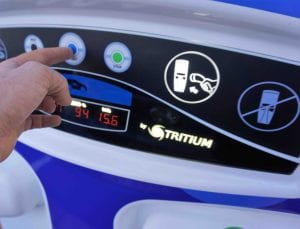Autonomous shuttle buses are ready for commercial deployment in Australia – and commuters are ready to ride on them – a new report has found.
The La Trobe University report, based on the findings of an “autonobus” trial at its Bundoora campus in outer Melbourne, says it demonstrated “safely and without incident” that AVs like this could be deployed now, to meet existing mobility needs and encourage more people to use public transport.
“Autonomous shuttle buses are ready for commercial deployment within a controlled environment, accompanied by appropriate risk, safety and incident management plans,” the report says.
The project – as we reported here – was the third trial of the driverless autonobus (others were conducted in Auckland and Sydney), developed by New Zealand-based company HMI Technologies.
In the La Trobe trial, the small bus was used to ferry students (max speed 20km/hour) from a nearby tram stop to the main campus, which – this La Trobe alumnus can confirm – is one of the most sprawling university campuses in metropolitan Australia.

Dean Zabrieszach, the CEO of HMI Technologies, says the AV passed every test it underwent during the six-month La Trobe University trial.
“The vehicle was put through rigorous safety, technical, operational and passenger testing on a pre-programmed route, interacting with pedestrians, cars, buses and cyclists,” he said.
“No other trial in Australia has tested an autonomous vehicle of this type in such a dense urban location.
“We have demonstrated that it can be done – safely, without incident and in compliance with road safety laws.
“The technology is ready for deployment in other similar environments where there is high activity and a controlled set of circumstances, including first and last mile transport services.”
According to HMI, it is these sort of “last mile solutions” that will make public transport more attractive, by connecting people safely and efficiently from transport hubs to their destination.
At the same time, they would lead to less congestion and pollution on the roads and less need for large, expensive road and parking infrastructure.
The La Trobe trial, which ran from April this year until July, was a collaboration between VicRoads, Keolis Downer, HMI, RACV and the Australian Road Research Board (ARRB), and was part-funded by the Victorian government Smarter Journeys Program.
As well as demonstrating the safe interaction between AVs and other road users, a key aim of the pilot was to gauge public attitudes to using AVs as a complement to mass transit services.
Overwhelmingly, the report found, the commuter feedback was positive, with the vast majority (90%) of users saying they felt comfortable and safe on the autonobus, and would gladly use – and pay for – such a service in the future.
“What we have learnt can assist us in making the roll out of autonomous vehicles a reality in the immediate future,” said Keolis Downer CEO David Franks.
“The trial demonstrated autonomous buses can and should play an important role in the mobility mix as a complementary service to existing public transport.
“We now have the data to show they can operate safely within complex environments and that there is strong public support for them.”
The report also found, however, that for the commercial rollout of autonomous vehicles to be a neat-term success, governments at the federal, state and local level – alongside statutory bodies – would need to get on board.
“Governments… (need to) prepare further for the introduction of this innovative transport technology – by amending regulations to facilitate the deployment of AVs and by ensuring infrastructure that supports the implementation of AVs is fully integrated into the planning process for transport and urban developments,” it says.
*For more news on electric and autonomous vehicles, look out for our new website, to be launched on Thursday










